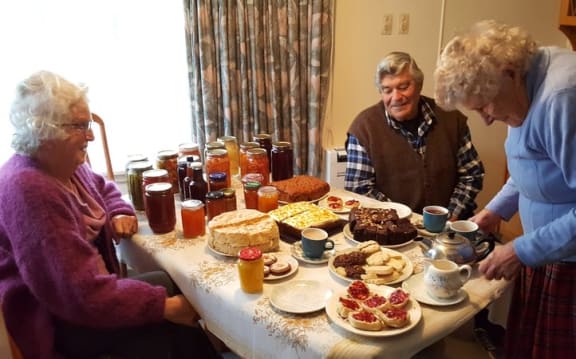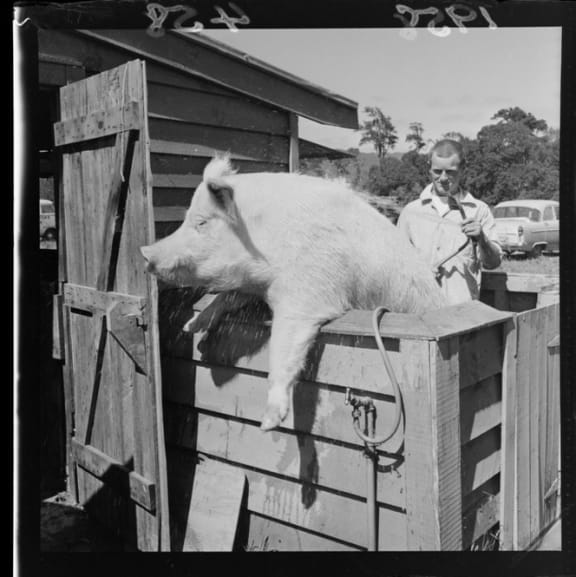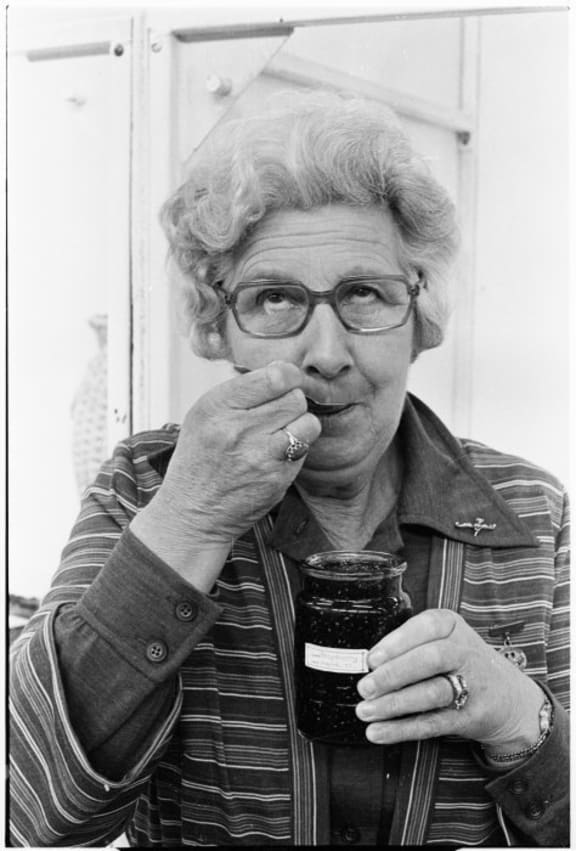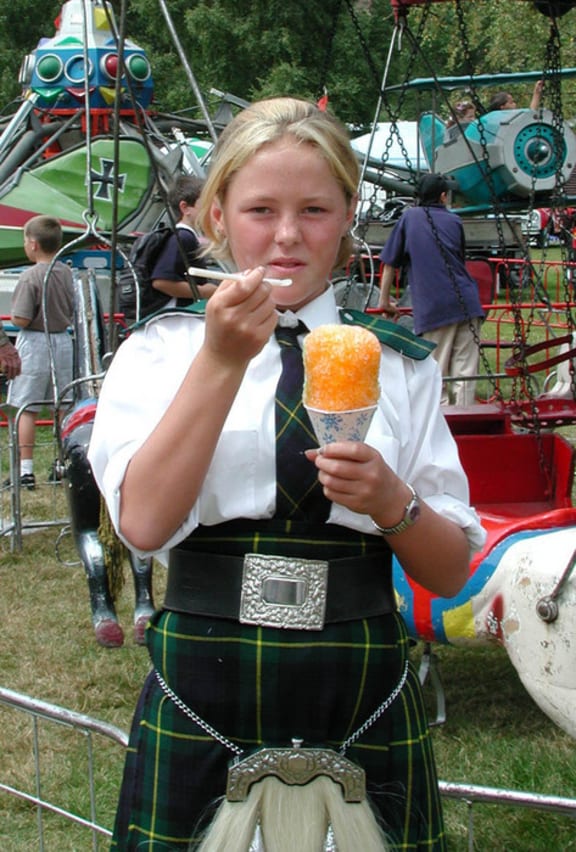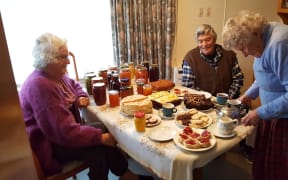It is Cup and Show Week in Christchurch, which means racing at Addington and Riccarton race courses and the country’s biggest A&P Show.
Photo: Ngā Taonga Sound & Vision
This year the Canterbury Show has been renamed and is now The New Zealand Agricultural Show.
- Watch film of the 1953 Auckland Easter A & P Show
- Watch film of the 1926 Royal A & P show in Auckland
First cut: 'Best show in New Zealand'
Sarah Johnston has been listening to the sound archives at Ngā Taonga Sound & Vision for past radio coverage of the week when “the country comes to town."
She says rural broadcasters have covered many of the country’s A&P shows over the years.
"It's such a great area to find great sounds - so you've got all the animals and old machinery and tractors and sideshows and things.
"Documentary makers like the Spectrum team found lots of good material there."
Attendee: "This is, in my opinion, what it's worth. It's the best show in New Zealand.
"My favourite possie is in the bar..."
Reporter: "And there'd be plenty who'd agree that the Canterbury A&P show is indeed the best in the country.
"Show week brings a flood tide of livestock and their breeders along with a myriad of trade exhibitors to cram into the A&P showgrounds from all over the South Island, not to mention a sprinkling from the North as well. By the end of this three-day event in early November more than 100,000 visitors will have passed through the gates.
"But to appreciate the heart of the show you really have to be there in the main stand for the grand parade when some of the cream of this country's bloodstock fills the main oval.
Announcer: "Now you're seeing it, the greatest grand parade in New Zealand. To cast your eye right across the grounds, a huge display - and still they pour in.
Reporter: "Even with their showing days now in the past, many retired farmers still keep their interest and involvement in stock. Among them is David Cassells who's filling in time between judging assignments watching some ponies being put through their paces in the main parade ground.
David: "One of the great things of course is getting here early in the morning and feeding the animals and then getting under the grandstand and having your own breakfast."
Reporter: "A good sort of healthy competition between farmers?"
David: "Oh, very healthy, sometimes quite unhealthy ... there was one occasion many many years ago when there was an argument ... which was the more superior breed, either the Corriedale or the half-breed.
"One of the protagonists decided to settle the argument by letting his competitor's ram out with his in the alleyway to have a fight and in fact it was with difficulty that the owners were separated.
Reporter: "It would have been a major exercise getting cattle, sheep from Otago up to here."
David: "Oh yes, in the early days of course we used to have to put them on the back of the express in wagons that had green rushes laid on the floor so the sparks wouldn't ignite the straw. And we used to unload them back at the siding over there and then take them home on the back of the express at the end of the week. We were up here from over 10 days."
Second cut: How to judge a prize-winning cow
Johnston notes cattle are appearing at the Canterbury show this week despite being banned at many of the smaller shows in efforts to limit the spread of mycoplasma bovis.
"But there's been very strict biosecurity prevcautions put in place. THis next cut is from simpler times. This is fromt he wairarapa show in Masterton in 1976.
"We're hearing here froma dairy breeds judge who is only identified as 'Ken' and he's explaining to Spectrum listeners the finer points of a prizewinning dairy cow.
Ken: "The three dairy breeds here are freisian, ayreshire and jersey, all represented. These are ayreshires these brown and white ones, these yellowy ones are jerseys, the freisians are the black and whites.
"Dairy cattle need to have fine bone - you don't want coarse bone, that's alright for beef cattle where you pay for what they weigh on the scale.
"See the head, they want a wide muzzle - that's a sign that they can get a good swath of grass at a time you see - a good open nostril so they can breathe well.
"The eye, reasonably prominent and alert, and the head dished a bit between the eyes. Earns nice and even now and a fine neck coming back onto the shoulders.
"These shoulders need to be fine, you don't want a lot of meat here.
"These ribs here ... those are the rib bones, now, you want them to be wide and fat. Wide and plenty of space in between: it's all for expansion, being able to when they eat something being able to go out and fill themselves up.
"These are the pin bones and they should be high and wide ... if they're narrow they can have trouble calving.
"Plenty of width between the hind legs because that's where the udders go ... the udder needs to come well up and a good wide attachment. They're usually heavy and if they haven't got a wide attachment the udder will drop and there's nothing that's worse than a dropped-udder cow.
"The udder need to come well forward on there onto the body, evenly placed - four teats evenly placed.
Third cut: Baking expertise
The A&P Show is a lot more than just livestock - there are also competitions, including baking and preserving.
"This is only from last year but it's still in the sound archives, this is Country Life's Cosmo Kentish-Barnes, and he did this interview last year with these two wonderful ladies who are from North Canterbury," Johnston says.
"They are very experienced A&P show competitors and judges, and they were so worried that young people were no longer learning all the skills required for competitive baking and preserving that they held a workshop to pass on a few of the hints.
Read Country Life's article about Edna Crawford and Ruth Wheeler:
Bake to the Future
Baking and preserving enthusiasts Edna Crawford and Ruth Wheeler have been on the North Canterbury A&P show circuit for over 50 years. Video, Audio
Edna: "Chocolate cakes must never have anything on it, it has to be plain chocolate icing."
Cosmo: "This one in front of us has some walnuts on it but in competition that wouldn't be advisable to do that."
Edna: "And your belgium biscuits have got to have white icing and red jelly crystals on them."
Cosmo: "If your icing was yellow you would instantly be marked down."
Edna: "Your afghans must have a half walnut on them."
Cosmo: "Can you have too many fork marks into shortbread?"
Edna: "Yes you can, you must have three and then a true shortbread should be pale in colour."
"When you're judging you must taste everything because any cook can add extra - baking powder or salt - and it's all in taste.
